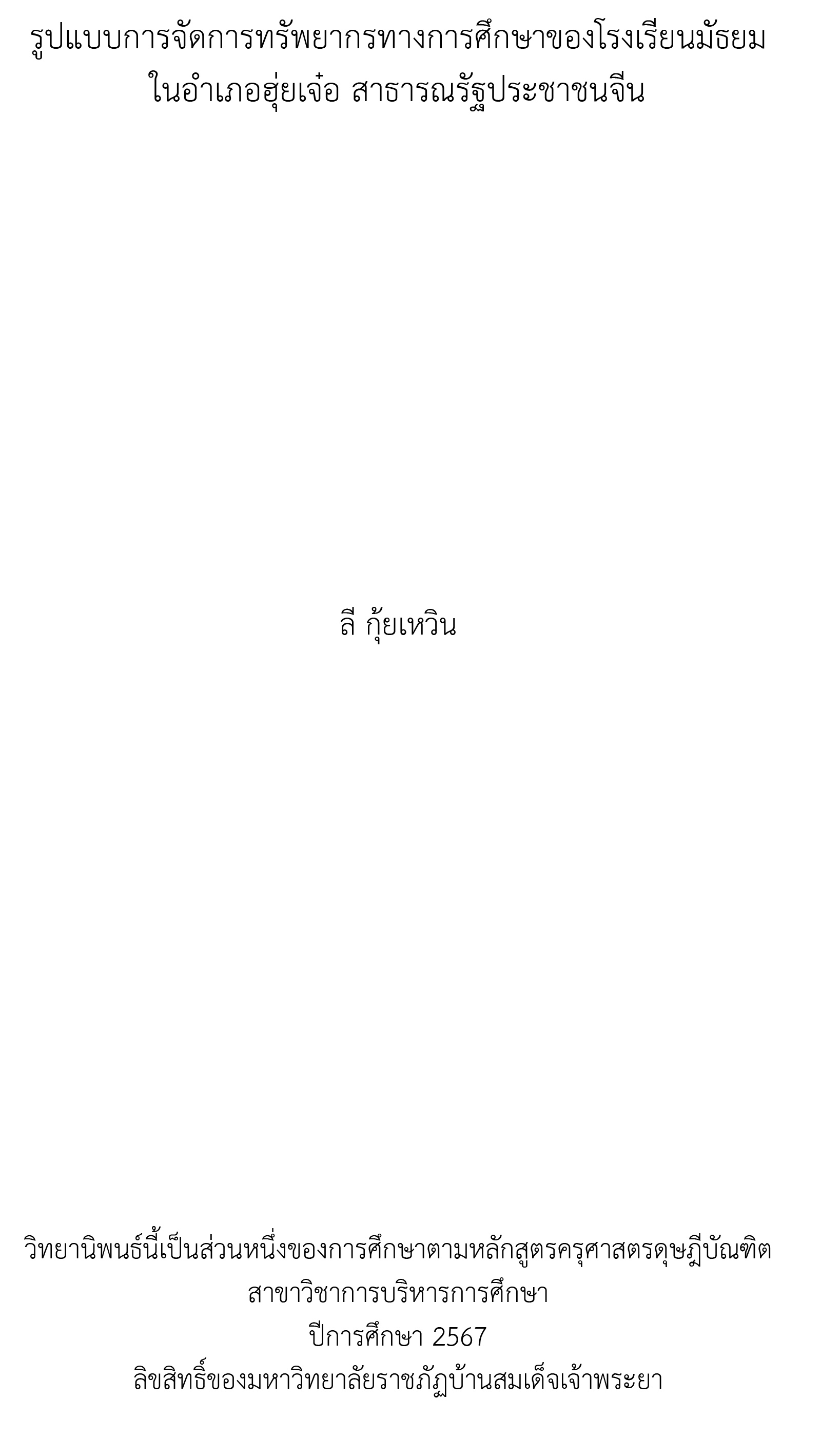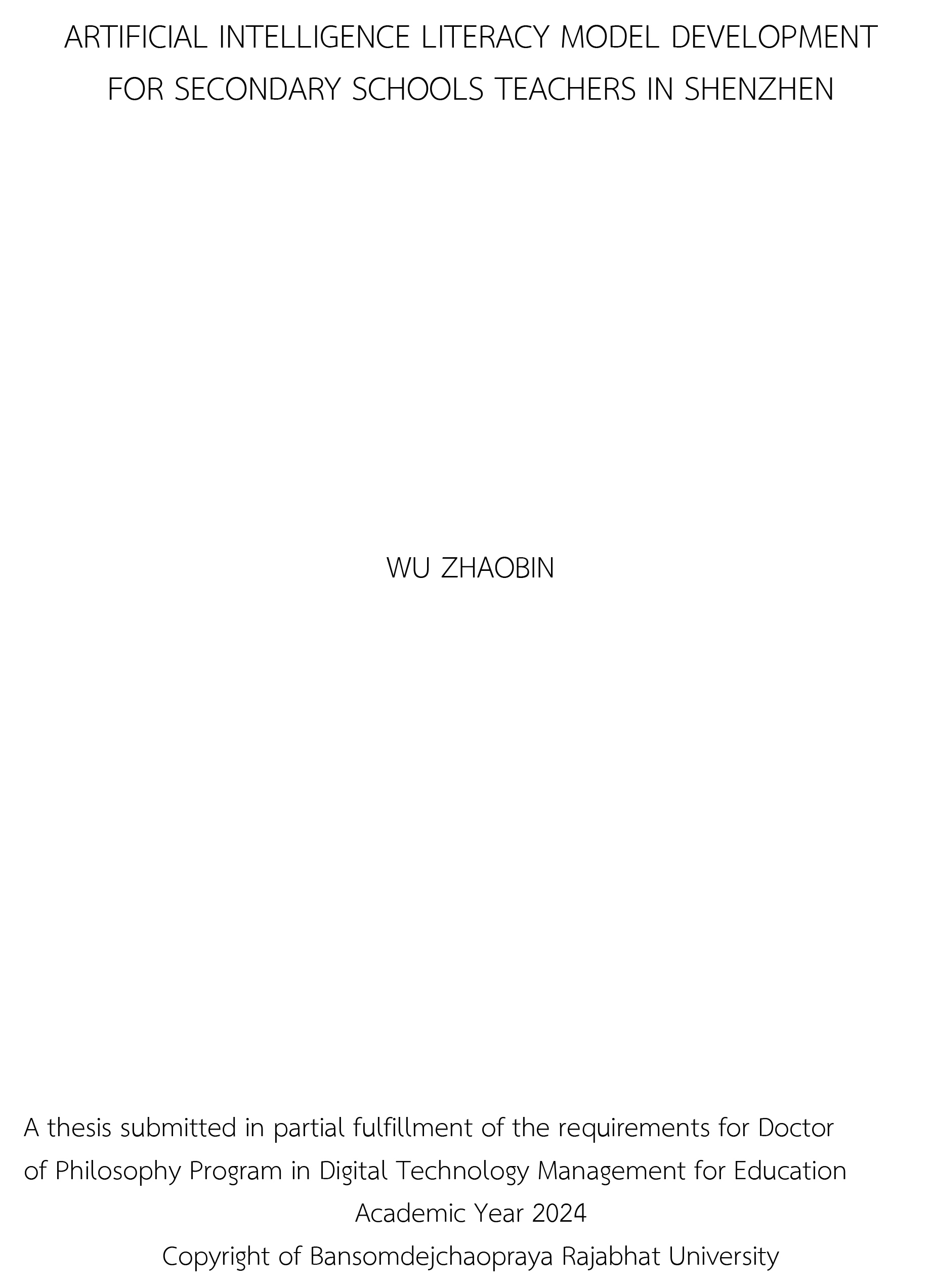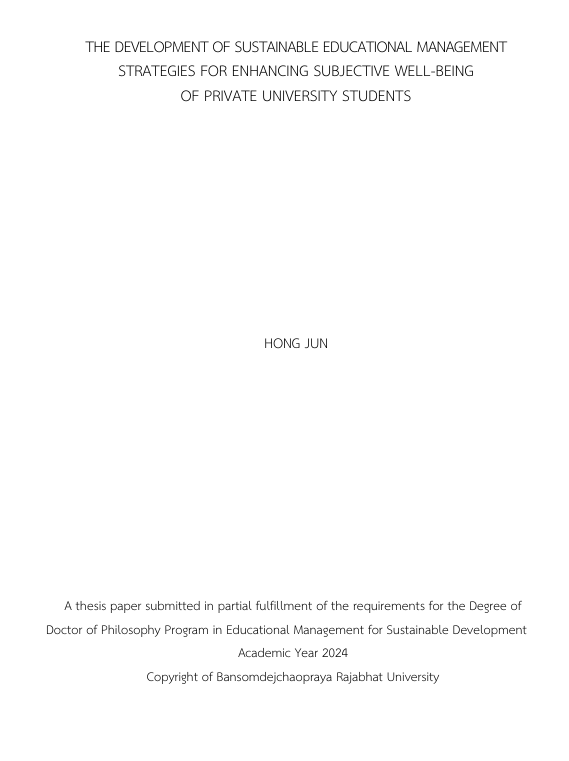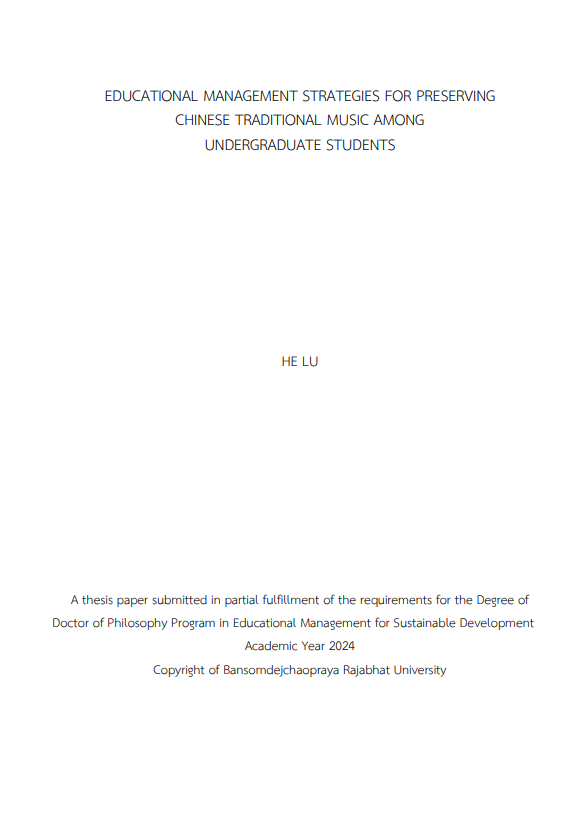-

การวิจัยครั้งนี้มีวัตถุประสงค์เพื่อศึกษาการจัดการทรัพยากรทางการศึกษาของโรงเรียนมัธยมในอำเภอฮุ่ยเจ๋อ สาธารณรัฐประชาชนจีน และเพื่อศึกษารูปแบบการจัดการทรัพยากรทางการศึกษาของ
โรงเรียนมัธยมในอำเภอฮุ่ยเจ๋อ สาธารณรัฐประชาชนจีน และเพื่อประเมินรูปแบบการจัดการทรัพยากรทางการศึกษาของโรงเรียนมัธยมในอำเภอฮุ่ยเจ๋อ สาธารณรัฐประชาชนจีนใน 6 ด้าน ประกอบด้วย 1) ทรัพยากรด้านบุคคล 2) ทรัพยากรด้านการเงิน 3) ทรัพยากรด้านวัสดุ อุปกรณ์ และอาคารสถานที่ 4)ทรัพยากรด้านบริหารจัดการ 5) ทรัพยากรดเานเวลา 6) ทรัพยากรด้านเทคโนโลยีสารสนเทศ ประชากรที่ใช้ในการวิจัยครั้งนี้ ได้แก่ โรงเรียนมัธยมในอำเภอฮุ่ยเจ๋อจำนวน 7 โรงเรียน จำนวน 1,638 คน ประเทศสาธารณรัฐประชาชนจีน กลุ่มตัวอย่างที่ใช้ในการศึกษาครั้งนี้ได้แก่ ผู้บริหาร คณะครูและบุคลากรทางการศึกษา โรงเรียนมัธยมในอำเภอฮุ่ยเจ๋อ โดยการสุ่มแบบเจาะจงจากโรงเรียนมัธยมในอำเภอฮุ่ยเจ๋อ 7 แห่ง รวมทั้งสิ้น 310 คน กลุุ่มผู้ให้ข้อมูลประเมินรอบที่ 1 ได้แก่ ผู้บริหาร คณะครูและบุคลากรทางการศึกษาโรงเรียนมัธยมในอำเภอฮุ่ยเจ๋อ รวมทั้งสิ้น 10 คน กลุ่มผู้ให้ข้อมูลการสัมภาษณ์ ประกอบด้วย
ผู้ทรงคุณวุฒิ ผู้บริหาร คณะครูและบุคลากรทางการศึกษา และผู้ที่มีบทบาทหลักของการจัดการทรัพยากรทางการศึกษาจำนวน 20 คน เครื่องมือที่ใช้ในการวิจัยเป็นแบบสอบถามมาตรประมาณค่า 5 ระดับ สถิติที่ใช้ในการวิเคราะห์ข้อมูล ได้แก่ ค่าร้อยละ ค่าเฉลี่ย และส่วนเบี่ยงเบนมาตรฐาน
ผลการวิจัยพบว่า รูปแบบการจัดการทรัพยากรทางการศึกษาของโรงเรียนมัธยมในอำเภอ ฮุ่ยเจ๋อ สาธารณรัฐประชาชนจีน โดยภาพรวมอยู่ในระดับมาก เมื่อพิจารณาเป็นรายด้าน พบว่า ทรัพยากรด้านเวลา มีค่าเฉลี่ยสูงสุด รองลงมาคือ ทรัพยากรด้านบริหารจัดการ ส่วนทรัพยากรด้านวัสดุอุปกรณ์ และอาคารสถานที่ มีค่าเฉลี่ยต่ำสุด โดยผู้บริหารโรงเรียนมัธยมในอำเภอฮุ่ยเจ๋อ สนับสนุนงบประมาณในการพัฒนาระบบสารสนเทศขององค์กร มีวิสัยทัศน์ที่กว้างไกลในการกำหนดเป็าหมายของสถานศึกษา สนับสนุนให้มีการจัดสภาพแวดล้อม ให้มีวัสดุอุปกรณ์เสริมสร้าง และส่งเสริมการเรียนรู้ที่หลากหลาย การพัฒนารูปแบบการจัดการทรัพยากรทางการศึกษา พบว่า 1) ทรัพยากรด้านบุคคล ได้รูปแบบดังนี้ มีทัศนคติที่ดีในการทำงาน มีความกระตือรือร้นใส่ใจในการทำงาน มีการวางแผนการดำเนินงาน มีการฝึกฝนพัฒนาตนเองอย่างต่อเนื่อง มีความสามัคคีต่อกัน 2) ทรัพยากรด้านการเงิน ได้รูปแบบดังนี้ การจัดการพฤติกรรมด้านการเงินที่เหมาะสม ให้คำแนะนำด้านการบริหารเงิน กำหนดเป้าหมายทางการเงินที่ชัดเจน การวางแผนด้านการเงินที่ดี มีการวิเคราะห์และควบคุมค่าใช้จ่าย 3) ทรัพยากรด้านวัสดุ อุปกรณ์ และอาคารสถานที่ ได้รูปแบบดังนี้ การวางแผนเพื่อการจัดการด้านวัสดุอุปกรณ์ และอาคารสถานที่ จัดสภาพแวดล้อมให้ช่วยลดมลภาวะในสถานศึกษา มีแผนงานรองรับในการปรับปรุง ซ่อมแชม อาคารสถานที่ มีเป้าหมายสอดคล้องกับบริบทของสถานศึกษา จัดสภาพแวดล้อมที่เอื้อต่อการเรียนรู้ และการปฏิบัติงาน 4) ทรัพยากรด้านบริหารจัดการ ได้รูปแบบดังนี้ มีการวางแผนการดำเนินงานอย่างเป็นระบบ มอบหมายงานตามความสามารถของแต่ละบุคคล พร้อมรับฟังความคิดเห็นที่หลากหลาย ใช้ทรัพยากรที่มีอยู่อย่างจำกัดได้อย่างมีประสิทธิภาพ จัดสภาพแวดล้อมที่ส่งเสริมต่อการปฏิบัติงาน 5) ทรัพยากรด้านเวลา ได้รูปแบบดังนี้ มีวิสัยทัศน์ที่กว้างไกล ให้ความสำคัญกับการควบคุมการใช้เวลาในการทำงานเสมอจัดทำกิจกรรมปฏิทินปฏิบัติงาน สนับสนุนการดำเนินงานที่สร้างสรรค์ วางแผนจัดการแบ่งเวลาในการใช้ชีวิตได้อย่างมีประสิทธิภาพ 6)ทรัพยากรด้านเทคโนโลยีสารสนเทศ ได้ รูปแบบดังนี้ การพัฒนาระบบสารสนเทศขององค์กรให้มีประสิทธิภาพ มีทัศนคติที่ที่ที่ต่อการใช้ระบบ สารสนเทศใช้ระบบสารสนเทศในการปฏิบัติงาน พร้อมจะเรียนรู้เมื่อมีระบบสารสนเทศใหม่ ๆ
คำสำคัญ : ทรัพยากรทางการศึกษา โรงเรียนมัธยมในอำเภอฮุ่ยเจ๋อ
-

This study aimed to 1) examine the current status of educational quality evaluation in application-oriented undergraduate colleges in Guangxi, 2) develop an evaluation indicator system for the educational quality of application-oriented undergraduate colleges in Guangxi, and 3) examine the system’s feasibility and adaptability. A mixed-methods approach was employed, combining quantitative methods (questionnaires) with qualitative techniques (document analysis, in-depth interviews, focus group discussions, and the Delphi method). Data were collected from 661 stakeholders, including teachers, administrators, and teaching supervisors.
The findings revealed that: 1) The overall educational quality in Guangxi’s application-oriented undergraduate colleges was moderate. Among the four dimensions (context, input, process, and output), the input dimension performed best, particularly in infrastructure and faculty development. In contrast, the output dimension was weakest, especially in graduate readiness and alignment with labour market needs, highlighting the necessity for a more outcome-oriented evaluation framework. 2) The evaluation system was developed through expert consultation and refined via the Delphi method. The final model comprised six first-level, 17 second-level, and 50 third-level indicators, encompassing the educational environment, development level, investment level, teacher level, school quality, and student quality. The system emphasises student-centredness, contextual relevance, and practical applicability. 3) Expert evaluations confirmed its high feasibility and adaptability, with mean scores of 4.33 and 4.15, respectively, indicating strong consensus. These findings affirm the system’s scientific rigour and practical utility as a tool for institutional assessment, policy development, and continuous quality improvement in application-oriented higher education in Guangxi.
Keywords: Evaluation Indicator System, Educational Quality, ApplicationOriented Undergraduate Colleges, Feasibility and Adaptability
-

The rapid evolution of information technology (IT) has transformed global healthcare systems, introducing innovative solutions for remote medical services. In the context of Traditional Chinese Medicine (TCM), a discipline deeply rooted in holistic and individualized treatment approaches, the integration of IT presents both opportunities and challenges. This dissertation proposes a comprehensive Decision Making Model for Remote Diagnosis and Treatment Courses in Traditional Chinese Medicine IT in China, aimed at enhancing clinical decision-making, improving treatment efficiency, and ensuring the sustainability of TCM in the digital era.
The proposed model is developed through a multi-disciplinary, expert-driven methodology, involving three distinct groups of professionals: 10 information technology experts, 10 TCM practitioners, and 10 experts specializing in remote diagnosis and treatment. The model was evaluated through a structured Delphi study and iterative expert consultations, ensuring that it not only reflects the latest advancements in IT infrastructure but also respects the philosophical and clinical principles inherent in TCM practice. The combined expertise of these 30 specialists resulted in a unanimous consensus affirming the scientific validity, practical feasibility, and clinical relevance of the decision-making framework.
Following this foundational validation, the model was subjected to a second round of critical assessment by a higher-level expert panel consisting of 9 senior authorities, each with extensive experience and recognized leadership in their respective domains. Their unanimous approval further confirms the model’s strategic importance and readiness for practical implementation in the national TCM telemedicine system.
The model features a layered structure that incorporates patient data acquisition, pattern recognition based on traditional diagnostics (such as pulse, tongue, and symptom differentiation), algorithmic decision-making supported by AI and cloud computing, and adaptive feedback mechanisms to continuously improve diagnostic accuracy and treatment outcomes. The model is particularly designed to support practitioners in rural and underserved areas, where access to high-level TCM expertise may be limited.
The significance of this study lies in its ability to bridge ancient medical wisdom with contemporary digital tools, creating a hybrid framework that supports personalized care, standardized procedures, and scalable implementation. This research also addresses key challenges in remote TCM practice, such as data tandardization, practitioner training, patient engagement, and legal-ethical considerations in cross-regional telemedicine delivery.
This dissertation contributes not only to academic knowledge but also offers a practical roadmap for policymakers, healthcare administrators, and medical IT developers aiming to build a more integrated and resilient healthcare system in China. Future research may expand this model to include cross-border applications, integration with Western medicine systems, and the use of big data analytics for national healthcare strategy development.
Keywords: Curriculum Development; Remote Diagnosis; Treatment Courses; Traditional Chinese Medicine; Information Technology
-

The objectives of this research were 1) to investigate the current situation and expected trend of sustainable development of lifelong learning in adult higher education in Zhejiang Province; 2) to develop strategies for the sustainable development of lifelong learning of adult higher education in Zhejiang Province; 3) to evaluate the adaptability and feasibility of the strategies sustainable development for lifelong learning of adult higher education in Zhejiang Province. The sample group of
this study 384 students and 10 interview experts, 10 focus group discussion experts and 5 strategy assessment experts. The research tools included 1) questionnaires; 2) interviews; 3) strategies; and 4) assessment forms. Statistical methods used to analyze the data included percentage, mean, standard deviation, modified Priority Needs Index (PNImodified) and content analysis. The research instruments included 1) questionnaires, 2) interview and 3) strategies, and 4) evaluation form. The statistic to analyze the data were percentages, mean, stand deviations, Modified Priority Needs
Index; (PNImodified) and content analysis.
The results of the study found
1) The current status of sustainable development of lifelong learning in adult education in Zhejiang Province is generally moderate. Considering the overall ideal situation, it is at a good level.
2) Formulate strategies for promoting lifelong learning in adult education in Zhejiang Province, including 26 strategies in 4 aspects, build institutional measures, including 6 strategies, improve the management system, including 8 strategies, enhance learning motivation, including 7 strategies, and evaluate education quality, including 5 strategies.
3) The feasibility and adaptability evaluation of strategies for promoting lifelong learning in adult education in Zhejiang Province, the overall evaluation result is the highest level.
Keywords: Strategies Developing; Lifelong Learning; Sustainable Development; Adult Higher Education
-

The purposes of this research were: 1) To study the current level of knowledge of secondary school teachers' artificial intelligence literacy. 2) To develop a teachers' artificial intelligence literacy improvement model for secondary schools. 3) To evaluate the teachers' artificial intelligence literacy improvement model.
The study invited 21 experts to conduct three rounds of consulting using the Delphi method to identify core competencies and refine the model components. This was done to determine the variable issues of effective teachers’ artificial intelligence literacy, resulting in the developing of a model for improving secondary school teachers' primary index factors includes: Cognition, Ethics, Artificial Intelligence Applications, Artificial Intelligence Pedagogy, Development, and Evaluation. artificial intelligence literacy. For the accuracy of the data, the interviewees were experts with professorial titles from artificial intelligence professionals, the online education field, and normal universities. The expert qualifies to have the rank of professor or above and has at least 20 years of experience working in a related field.
The results of the study found that 30 secondary school teachers in Shenzhen had significantly higher post-test scores than pre-test scores at a significance level of 0.05.
Keywords: Artificial Intelligence Literacy, TAILM Model, Teacher Professional Development, Delphi Method, Educational Technology, AI Ethics
-

สํานักวิทยบริการและเทคโนโลยีสารสนเทศ ภายใต้ชื่อรายการ มือไม่โปรก็โชว์ได้ ( EP.4 ) Build your own book สมุดทำมือ
ได้แนะนำวิธีการทำสมุดทำมือ ที่ไม่เพียงแต่เป็นการสร้างสรรค์ผลงานที่มีเอกลักษณ์ แต่ยังเป็นกิจกรรมที่ทำให้ผู้ชมสามารถใช้เวลาว่างให้เกิดประโยชน์ โดยการทำสมุดจดเลคเชอร์ที่สามารถปรับแต่งได้ตามสไตล์ของตัวเอง
ขั้นตอนการทำ
1. วัสดุอุปกรณ์: กระดาษ, กรรไกร, กระดูกงู (สันห่วงพลาสติก), สติกเกอร์
2. การประกอบ: เริ่มต้นจากการเลือกกระดาษที่ต้องการใช้ ทำการตัดและจัดเรียงให้เป็นรูปเล่ม
3. การติดสันห่วง: ใช้กระดูกงู (สันห่วงพลาสติก) เพื่อให้สมุดเป็นรูปเล่ม
4. การตกแต่งปก: วาดหรือใช้สติกเกอร์ตกแต่งหน้าปกให้มีเอกลักษณ์ตามสไตล์ของตนเอง
การทำสมุดทำมือในรายการนี้ช่วยให้ผู้ชมสามารถสร้างสรรค์ผลงานที่ไม่ซ้ำใคร โดยใช้วัสดุที่หาซื้อได้ง่ายๆ และยังช่วยให้ผู้ชมใช้เวลาว่างให้เกิดประโยชน์ พร้อมทั้งได้เรียนรู้กิจกรรมสร้างสรรค์ที่สนุกสนานจากห้องสมุด.
-

สํานักวิทยบริการและเทคโนโลยีสารสนเทศ ภายใต้ชื่อรายการ มือไม่โปรก็โชว์ได้ EP.3 พิมเสนดอกไม้ นำเสนอการทำพิมเสนน้ำที่มีส่วนผสมจากเมนทอล การบูร พิมเสน และน้ำมันยูคาลิปตัส ซึ่งช่วยบรรเทาอาการวิงเวียนศีรษะและคัดจมูก รวมถึงการใช้พิมเสนน้ำในการดูแลสุขภาพ และวิธีการตกแต่งขวดด้วยดอกไม้แห้งเพื่อเพิ่มความสวยงาม เพื่อสร้างผลิตภัณฑ์ที่สามารถใช้เองหรือนำมาขายเป็นรายได้เสริม
ส่วนผสมที่ใช้ ได้แก่:
1.เมนทอล 6 ช้อนชา
2.การบูร 1 ช้อนชา
3.พิมเสน 3 ช้อนชา
4.น้ำมันยูคาลิปตัส 1 ช้อนชา
ขั้นตอนการทำ
1.บดส่วนผสม: บดพิมเสน การบูร และเมนทอลให้ละเอียด
2.เติมน้ำมัน: นำส่วนผสมที่บดแล้วมาเติมน้ำมันยูคาลิปตัสและคนให้ละลายเข้ากัน
3.ตกแต่งขวด: นำดอกไม้แห้งมาตกแต่งภายในขวดให้สวยงาม
4.บรรจุขวด: บรรจุพิมเสนที่ละลายลงในขวดและปิดฝาให้สนิท
5.การเก็บรักษา: เก็บไว้ในที่แห้งและเย็น หลีกเลี่ยงแสงแดด
การทำพิมเสนน้ำไม่เพียงแต่ช่วยบรรเทาอาการไม่สบายตัว แต่ยังเป็นกิจกรรมที่สามารถทำได้เองและสามารถสร้างรายได้เสริมได้จากการขายผลิตภัณฑ์ที่ทำขึ้นเอง.
-

สํานักวิทยบริการและเทคโนโลยีสารสนเทศ ภายใต้ชื่อรายการ มือไม่โปรก็โชว์ได้ EP.2 เรื่อง Resin Style ดีไซน์ใส ใส่ไอเดีย นำเสนอขั้นตอนการประดิษฐ์งานเรซิน DIY อย่างละเอียด โดยวิทยากรได้สาธิตการทำชิ้นงานเรซินประเภทต่างๆ เช่น ที่รองแก้วและของตกแต่ง ชิ้นงานเหล่านี้ทำจาก อีพ็อกซีเรซิน และ ยูวีเรซิน ซึ่งมีระยะเวลาการเซ็ตตัวที่แตกต่างกัน ผู้สาธิตได้อธิบายถึง อุปกรณ์ที่จำเป็น เช่น แม่พิมพ์ ซิลิโคน สารเรซิน (A และ B) และวัสดุตกแต่ง เช่น กากเพชร และ ดอกไม้แห้ง นอกจากนี้ ยังให้ คำแนะนำและเคล็ดลับ ที่สำคัญ เช่น อัตราส่วนการผสมที่ถูกต้อง และเทคนิคการไล่ฟองอากาศด้วยปืนแก๊ส และขั้นตอนการตากแดดเพื่อให้ชิ้นงานแข็งตัวสมบูรณ์ ซึ่งสามารถนำไปต่อยอด สร้างอาชีพหรือทำเป็นงานอดิเรกได้
-

หมูกระดาษของป้าน้อยมีประวัติความเป็นมาที่น่าสนใจ โดยสืบทอดจากบรรพบุรุษมากกว่า 100 ปี ป้าน้อยได้รับแรงบันดาลใจในการทำหมูกระดาษจากคุณพ่อ ซึ่งเป็นผู้มีความเชื่อมั่นในการนำสิ่งของเหลือใช้มาใช้ให้เกิดประโยชน์สูงสุด คุณพ่อของป้าน้อยเคยทำหมูจากกระดาษเหลือใช้และปั้นเป็นออมสิน พร้อมทั้งสอนให้ลูกๆ ได้เรียนรู้การทำงานจากสิ่งที่มีอยู่แล้ว โดยยึดหลักการไม่สร้างขยะและใช้เวลาว่างในการทำงานศิลปะที่มีประโยชน์ต่อทั้งตัวเองและครอบครัว
-

เยี่ยมชม 'หลวงพ่อครุธ' และพญาครุฑ ในวัดเก่าแก่กว่า 300 ปี ริมคลองมอญ แม้ว่าจะไม่มีหลักฐานที่ชัดเจนเกี่ยวกับการสร้างวัดครุฑ แต่ชื่อของวัดปรากฏในเอกสารประวัติศาสตร์ เช่น ในจดหมายเหตุของคณะราชทูตพระเจ้าหลุยส์ที่ 14 แห่งฝรั่งเศส ซึ่งได้นำพระราชสาส์นมาถวายแด่สมเด็จพระนารายณ์มหาราช กรุงศรีอยุธยา ในโอกาสนั้น คณะราชทูตได้เดินทางมายังกรุงธนบุรี โดยการล่องเรือไปเยี่ยมชุมชนชาวฝรั่งเศส มีการบันทึกถึงวัดต่าง ๆ ในเขตกรุงธนบุรี อาทิ วัดนวลนรดิศวรวิหาร วัดครุฑ วัดเงิน (วัดรัชฎาธิษฐานราชวรวิหาร) และวัดทอง (วัดกาญจนสิงหาสน์วรวิหาร) จากหลักฐานดังกล่าว จึงสันนิษฐานได้ว่าวัดครุฑน่าจะสร้างขึ้นประมาณ พ.ศ. 2207 และได้รับพระราชทานวิสุงคามสีมาในปี พ.ศ. 2210 ซึ่งสอดคล้องกับพระประธานในพระอุโบสถที่เป็นศิลปะสมัยอยุธยาตอนปลาย วัดครุฑจึงเป็นวัดเก่าแก่ที่มีอายุกว่า 300 ปี
-

The objectives of this research were 1) To analyze the current conditions, desired conditions, and influencing factors that subjective well-being of private university students. 2) To develop sustainable educational management strategies for enhancing the subjective well-being of private university students. 3) To evaluate the feasibility and the adaptability of the strategies for the sustainable development of enhancing the subjective well-being of private university students. Stratified random sampling method was employed to select 384 private university students as the sample group for the questionnaire. Additionally, purposive sampling was used to select 12 experts for the interviews, and 12 experts for the focus discussion, and 5 experts for the strategy evaluation. The research instruments included a questionnaire, an interview, a draft strategy, and a strategy evaluation form. The statistics were Frequency, Percentage, Mean, Standard deviation, Modified Priority Needs Index (PNI Modified), and content analysis. The results were found that: 1) The current conditions, desired conditions of subjective well-being private university students can be divided into four factors: individual factors, family factors, school factors, and social factors. All levels are needed for development. 2) Strategies for enhancing the subjective well-being of private university students, as follows: (1) Activate the subject's initiative, (2) Establish a family support alliance, (3) Innovative school system supply, (4) Improve the social ecological environment. 3) The feasibility and adaptability evaluation results of the strategies were at respectively highest levels
Keywords: Sustainable Educational management strategies, Subjective well-being, Private university stud
-

The objectives of this research were 1) to study the current conditions and desired conditions for preserving Chinese traditional music among undergraduate students. 2) to formulate educational management strategies for preserving Chinese traditional music among undergraduate students. 3) to evaluate the feasibility and adaptability of educational management strategies for preserving Chinese traditional music among undergraduate students. A multi-stage sampling method was employed to select 322 undergraduate students as the sample group for the questionnaire.
Additionally, purposive sampling was used to select 15 teachers for the interviews, 10 experts for the focus group discussion, and 5 experts for the strategy evaluation. The research instruments included questionnaire, interview and evaluation form. The statistics were frequency and percentage, mean and standard deviation, Modified Priority Needs Index and content analysis.
The results were found that: 1) the current conditions and desired conditions for preserving Chinese traditional music among undergraduate students included six aspects, ranked from highest to lowest as follows: faculty development, digital infrastructure, student engagement, curriculum, policy & evaluation, community partnership. All aspects needed to development. 2) The educational management strategies for preserving Chinese traditional music among undergraduate students
consisted of six strategies, as followed: (1) strategies of optimizing curriculum, (2) strategies of strengthening faculty development, (3) strategies of stimulating student engagement, (4) strategies of upgrading digital infrastructure, (5) strategies of expanding community partnership, (6) strategies of refining policy and evaluation. 3) The feasibility and adaptability evaluation results of the strategies were in respectively highest levels.
Keywords: Educational management strategies, Preserving Chinese traditional music, Undergraduate students












